Research: Leadership Role in Organizational Safety Culture, Abu Dhabi
VerifiedAdded on 2020/05/11
|18
|4188
|96
Report
AI Summary
This report investigates the pivotal role of leadership in fostering a robust safety culture within government sectors in Abu Dhabi, UAE. It begins by defining leadership and exploring various leadership styles, such as Laissez-Faire, Transactional, Autocratic, Transformational and Participative. The report then analyzes the significance of leadership in promoting organizational safety, emphasizing how leaders can influence employee behavior and implement changes effectively. Key research objectives include understanding leadership styles, assessing their impact on safety culture, identifying leadership challenges, and exploring solutions. The methodology involves a literature review, outlining research questions, and detailing the research design, which includes research philosophy, type, and approach. The report also examines the challenges leaders face, such as conflicts, motivating employees, team management, and adapting to change, and suggests ways to mitigate these challenges through training, communication, and establishing a strong safety culture. The conclusion summarizes the findings and emphasizes the importance of leadership in ensuring a safe and productive work environment. The report also includes a detailed research methodology section.
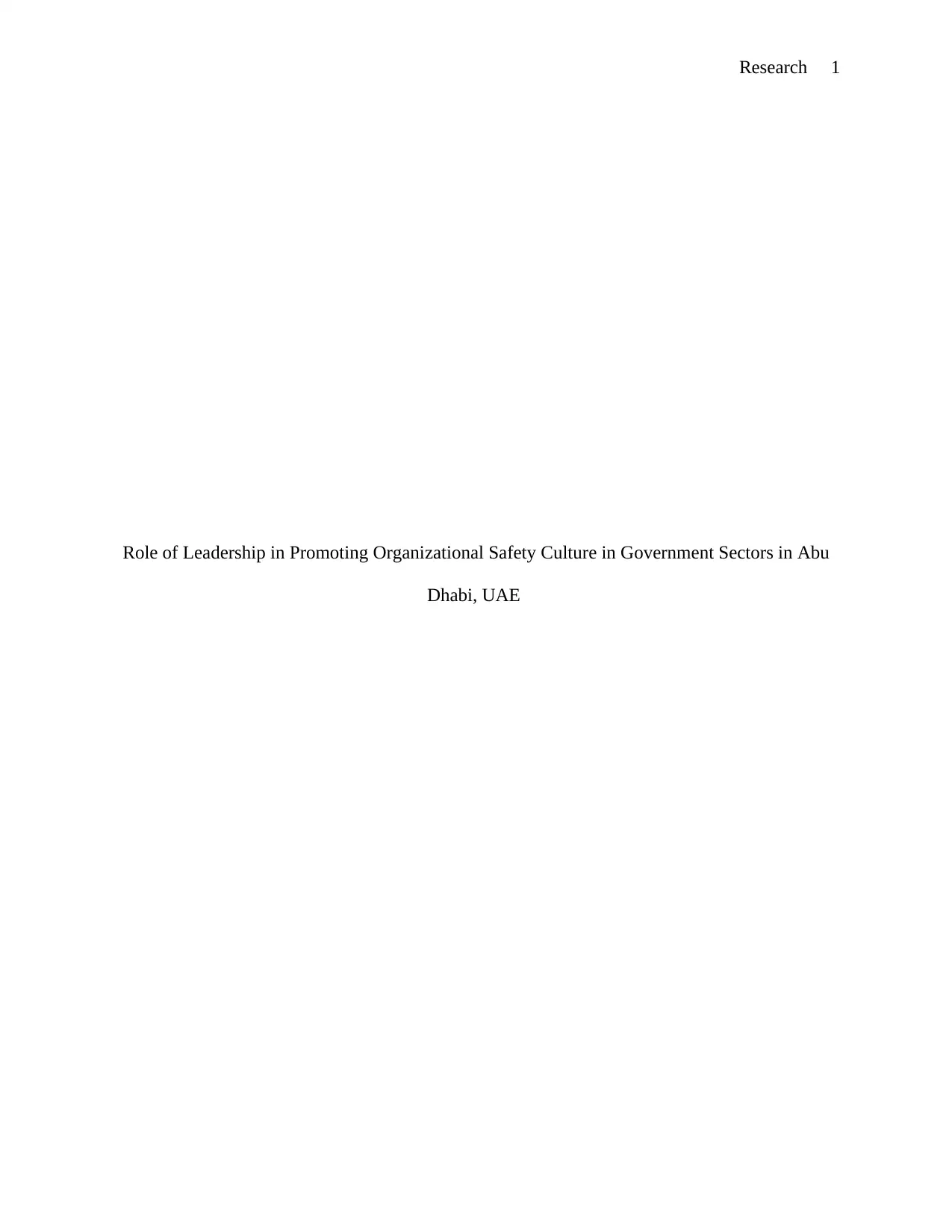
Research 1
Role of Leadership in Promoting Organizational Safety Culture in Government Sectors in Abu
Dhabi, UAE
Role of Leadership in Promoting Organizational Safety Culture in Government Sectors in Abu
Dhabi, UAE
Paraphrase This Document
Need a fresh take? Get an instant paraphrase of this document with our AI Paraphraser
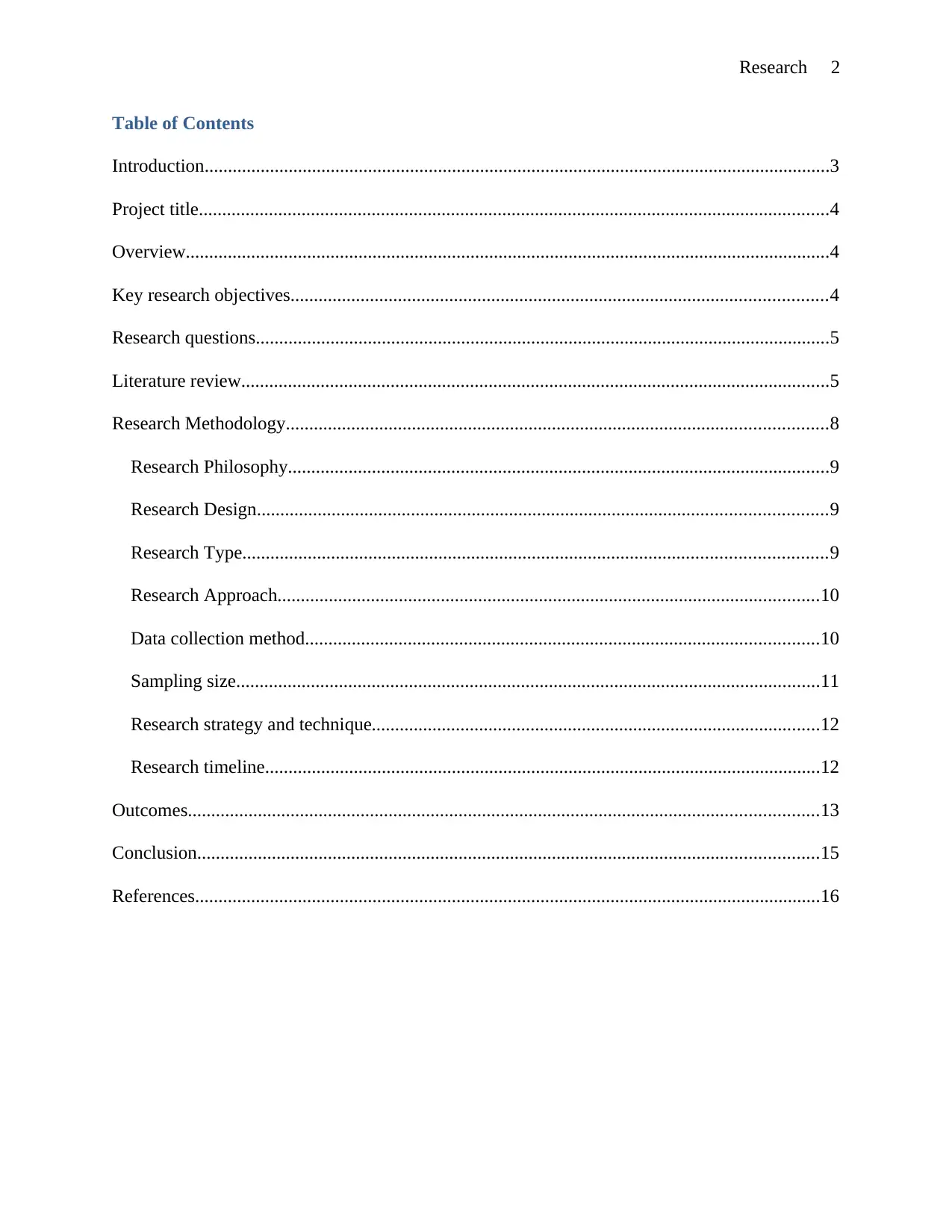
Research 2
Table of Contents
Introduction......................................................................................................................................3
Project title.......................................................................................................................................4
Overview..........................................................................................................................................4
Key research objectives...................................................................................................................4
Research questions...........................................................................................................................5
Literature review..............................................................................................................................5
Research Methodology....................................................................................................................8
Research Philosophy....................................................................................................................9
Research Design..........................................................................................................................9
Research Type.............................................................................................................................9
Research Approach....................................................................................................................10
Data collection method..............................................................................................................10
Sampling size.............................................................................................................................11
Research strategy and technique................................................................................................12
Research timeline.......................................................................................................................12
Outcomes.......................................................................................................................................13
Conclusion.....................................................................................................................................15
References......................................................................................................................................16
Table of Contents
Introduction......................................................................................................................................3
Project title.......................................................................................................................................4
Overview..........................................................................................................................................4
Key research objectives...................................................................................................................4
Research questions...........................................................................................................................5
Literature review..............................................................................................................................5
Research Methodology....................................................................................................................8
Research Philosophy....................................................................................................................9
Research Design..........................................................................................................................9
Research Type.............................................................................................................................9
Research Approach....................................................................................................................10
Data collection method..............................................................................................................10
Sampling size.............................................................................................................................11
Research strategy and technique................................................................................................12
Research timeline.......................................................................................................................12
Outcomes.......................................................................................................................................13
Conclusion.....................................................................................................................................15
References......................................................................................................................................16
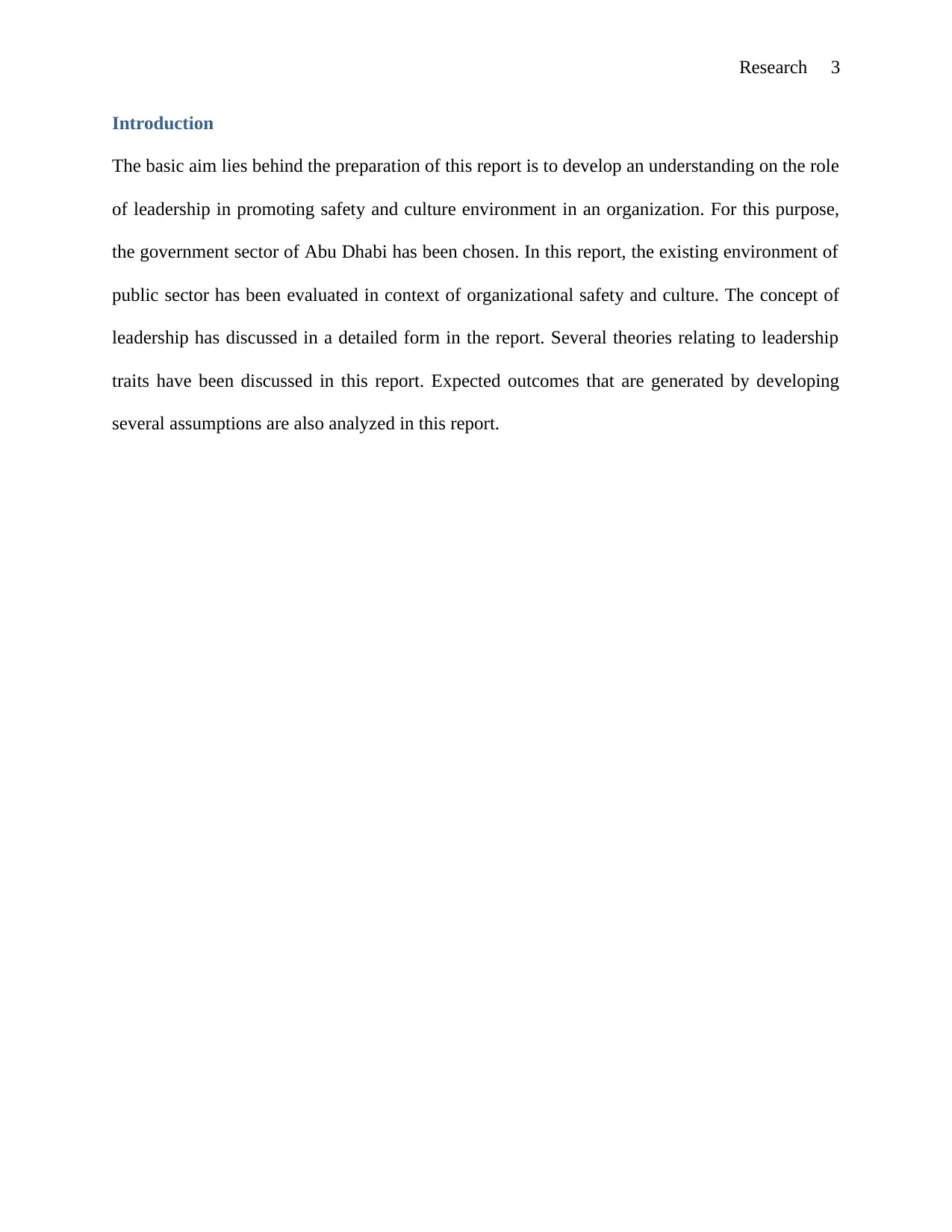
Research 3
Introduction
The basic aim lies behind the preparation of this report is to develop an understanding on the role
of leadership in promoting safety and culture environment in an organization. For this purpose,
the government sector of Abu Dhabi has been chosen. In this report, the existing environment of
public sector has been evaluated in context of organizational safety and culture. The concept of
leadership has discussed in a detailed form in the report. Several theories relating to leadership
traits have been discussed in this report. Expected outcomes that are generated by developing
several assumptions are also analyzed in this report.
Introduction
The basic aim lies behind the preparation of this report is to develop an understanding on the role
of leadership in promoting safety and culture environment in an organization. For this purpose,
the government sector of Abu Dhabi has been chosen. In this report, the existing environment of
public sector has been evaluated in context of organizational safety and culture. The concept of
leadership has discussed in a detailed form in the report. Several theories relating to leadership
traits have been discussed in this report. Expected outcomes that are generated by developing
several assumptions are also analyzed in this report.
⊘ This is a preview!⊘
Do you want full access?
Subscribe today to unlock all pages.

Trusted by 1+ million students worldwide
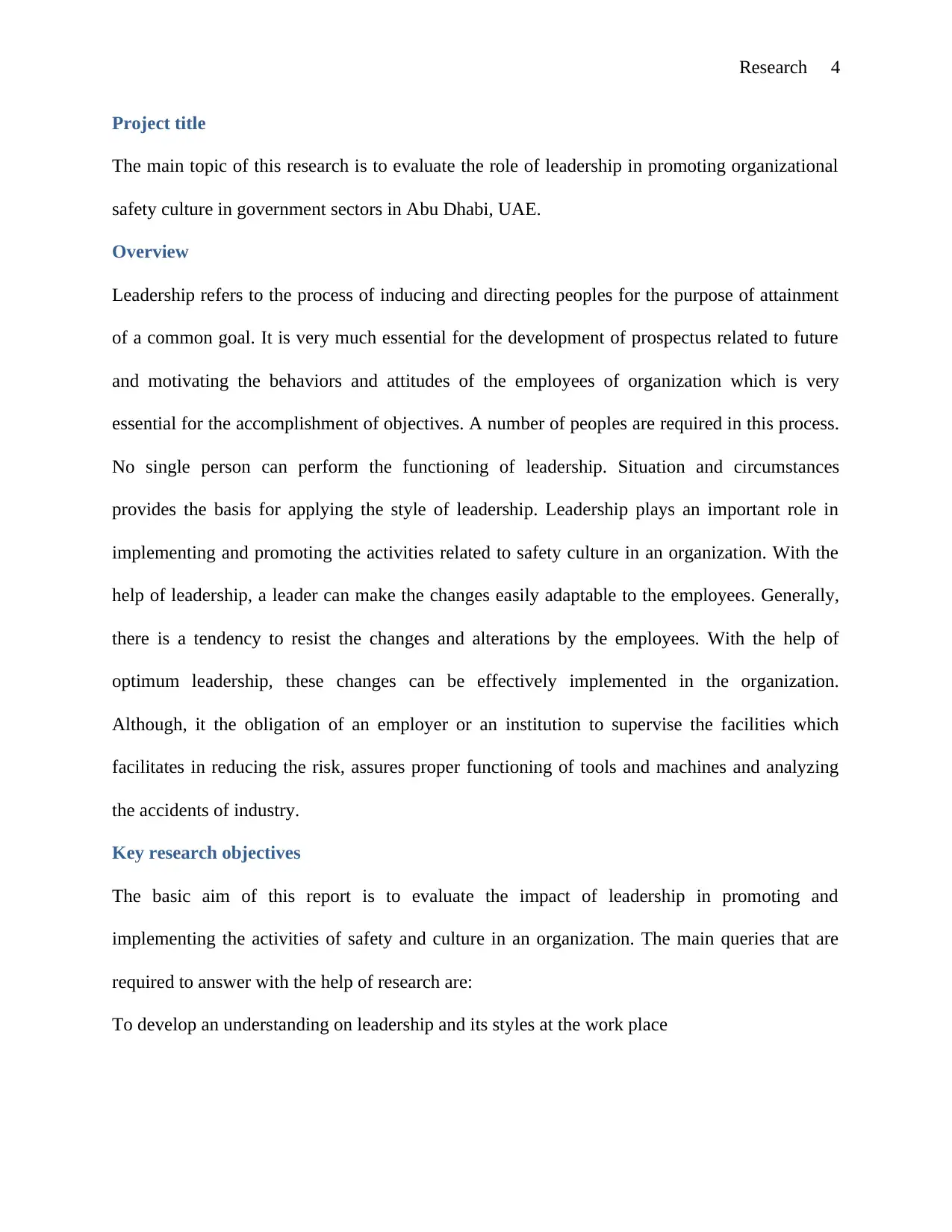
Research 4
Project title
The main topic of this research is to evaluate the role of leadership in promoting organizational
safety culture in government sectors in Abu Dhabi, UAE.
Overview
Leadership refers to the process of inducing and directing peoples for the purpose of attainment
of a common goal. It is very much essential for the development of prospectus related to future
and motivating the behaviors and attitudes of the employees of organization which is very
essential for the accomplishment of objectives. A number of peoples are required in this process.
No single person can perform the functioning of leadership. Situation and circumstances
provides the basis for applying the style of leadership. Leadership plays an important role in
implementing and promoting the activities related to safety culture in an organization. With the
help of leadership, a leader can make the changes easily adaptable to the employees. Generally,
there is a tendency to resist the changes and alterations by the employees. With the help of
optimum leadership, these changes can be effectively implemented in the organization.
Although, it the obligation of an employer or an institution to supervise the facilities which
facilitates in reducing the risk, assures proper functioning of tools and machines and analyzing
the accidents of industry.
Key research objectives
The basic aim of this report is to evaluate the impact of leadership in promoting and
implementing the activities of safety and culture in an organization. The main queries that are
required to answer with the help of research are:
To develop an understanding on leadership and its styles at the work place
Project title
The main topic of this research is to evaluate the role of leadership in promoting organizational
safety culture in government sectors in Abu Dhabi, UAE.
Overview
Leadership refers to the process of inducing and directing peoples for the purpose of attainment
of a common goal. It is very much essential for the development of prospectus related to future
and motivating the behaviors and attitudes of the employees of organization which is very
essential for the accomplishment of objectives. A number of peoples are required in this process.
No single person can perform the functioning of leadership. Situation and circumstances
provides the basis for applying the style of leadership. Leadership plays an important role in
implementing and promoting the activities related to safety culture in an organization. With the
help of leadership, a leader can make the changes easily adaptable to the employees. Generally,
there is a tendency to resist the changes and alterations by the employees. With the help of
optimum leadership, these changes can be effectively implemented in the organization.
Although, it the obligation of an employer or an institution to supervise the facilities which
facilitates in reducing the risk, assures proper functioning of tools and machines and analyzing
the accidents of industry.
Key research objectives
The basic aim of this report is to evaluate the impact of leadership in promoting and
implementing the activities of safety and culture in an organization. The main queries that are
required to answer with the help of research are:
To develop an understanding on leadership and its styles at the work place
Paraphrase This Document
Need a fresh take? Get an instant paraphrase of this document with our AI Paraphraser
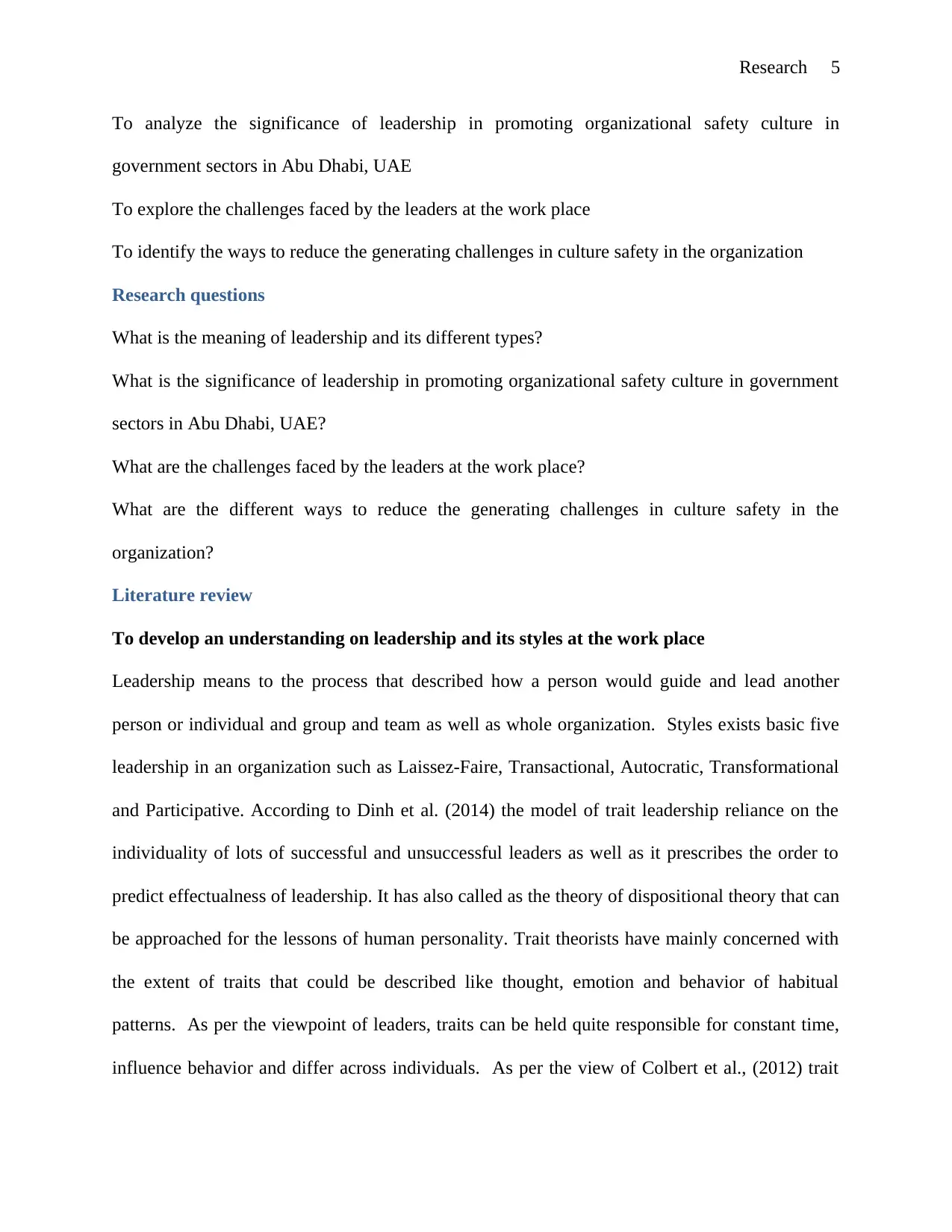
Research 5
To analyze the significance of leadership in promoting organizational safety culture in
government sectors in Abu Dhabi, UAE
To explore the challenges faced by the leaders at the work place
To identify the ways to reduce the generating challenges in culture safety in the organization
Research questions
What is the meaning of leadership and its different types?
What is the significance of leadership in promoting organizational safety culture in government
sectors in Abu Dhabi, UAE?
What are the challenges faced by the leaders at the work place?
What are the different ways to reduce the generating challenges in culture safety in the
organization?
Literature review
To develop an understanding on leadership and its styles at the work place
Leadership means to the process that described how a person would guide and lead another
person or individual and group and team as well as whole organization. Styles exists basic five
leadership in an organization such as Laissez-Faire, Transactional, Autocratic, Transformational
and Participative. According to Dinh et al. (2014) the model of trait leadership reliance on the
individuality of lots of successful and unsuccessful leaders as well as it prescribes the order to
predict effectualness of leadership. It has also called as the theory of dispositional theory that can
be approached for the lessons of human personality. Trait theorists have mainly concerned with
the extent of traits that could be described like thought, emotion and behavior of habitual
patterns. As per the viewpoint of leaders, traits can be held quite responsible for constant time,
influence behavior and differ across individuals. As per the view of Colbert et al., (2012) trait
To analyze the significance of leadership in promoting organizational safety culture in
government sectors in Abu Dhabi, UAE
To explore the challenges faced by the leaders at the work place
To identify the ways to reduce the generating challenges in culture safety in the organization
Research questions
What is the meaning of leadership and its different types?
What is the significance of leadership in promoting organizational safety culture in government
sectors in Abu Dhabi, UAE?
What are the challenges faced by the leaders at the work place?
What are the different ways to reduce the generating challenges in culture safety in the
organization?
Literature review
To develop an understanding on leadership and its styles at the work place
Leadership means to the process that described how a person would guide and lead another
person or individual and group and team as well as whole organization. Styles exists basic five
leadership in an organization such as Laissez-Faire, Transactional, Autocratic, Transformational
and Participative. According to Dinh et al. (2014) the model of trait leadership reliance on the
individuality of lots of successful and unsuccessful leaders as well as it prescribes the order to
predict effectualness of leadership. It has also called as the theory of dispositional theory that can
be approached for the lessons of human personality. Trait theorists have mainly concerned with
the extent of traits that could be described like thought, emotion and behavior of habitual
patterns. As per the viewpoint of leaders, traits can be held quite responsible for constant time,
influence behavior and differ across individuals. As per the view of Colbert et al., (2012) trait
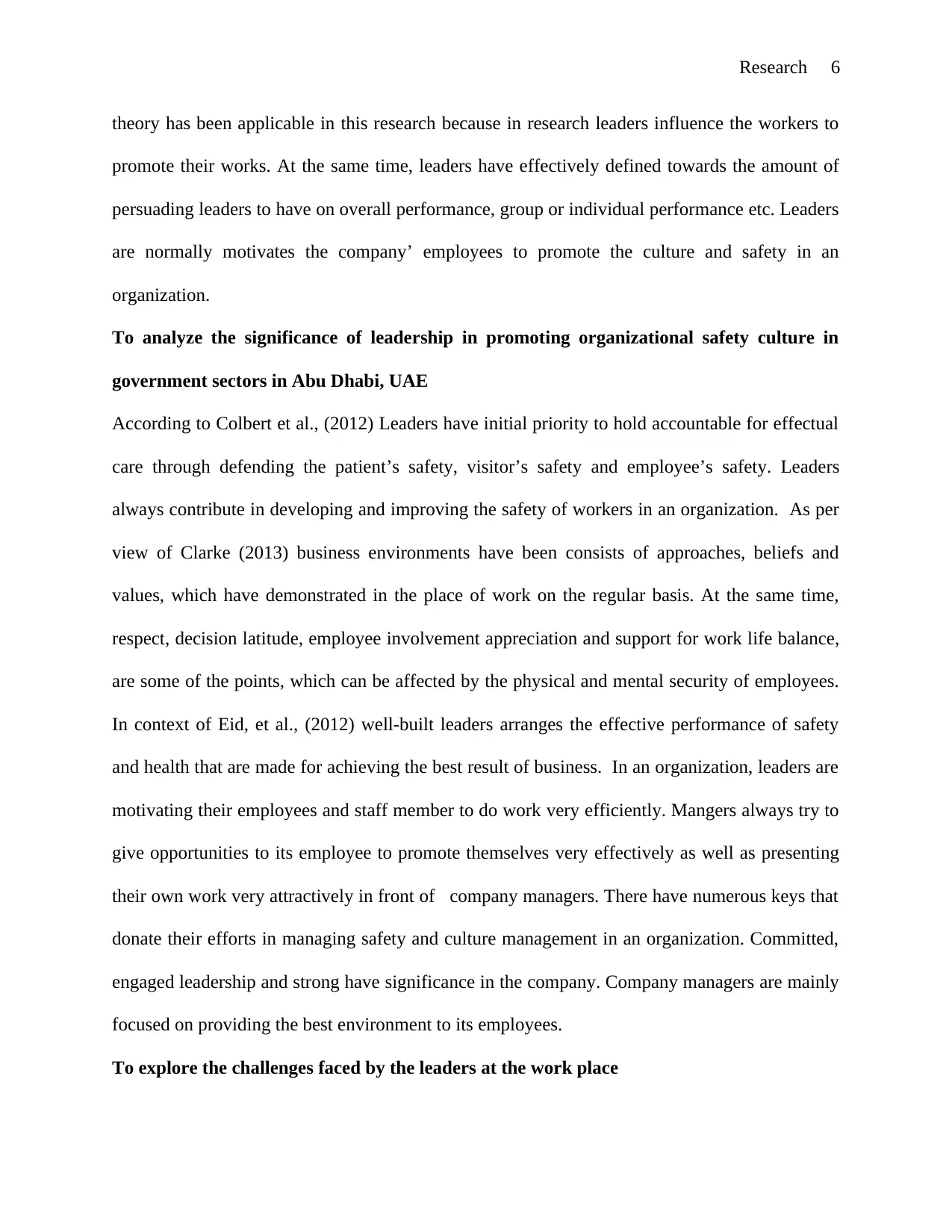
Research 6
theory has been applicable in this research because in research leaders influence the workers to
promote their works. At the same time, leaders have effectively defined towards the amount of
persuading leaders to have on overall performance, group or individual performance etc. Leaders
are normally motivates the company’ employees to promote the culture and safety in an
organization.
To analyze the significance of leadership in promoting organizational safety culture in
government sectors in Abu Dhabi, UAE
According to Colbert et al., (2012) Leaders have initial priority to hold accountable for effectual
care through defending the patient’s safety, visitor’s safety and employee’s safety. Leaders
always contribute in developing and improving the safety of workers in an organization. As per
view of Clarke (2013) business environments have been consists of approaches, beliefs and
values, which have demonstrated in the place of work on the regular basis. At the same time,
respect, decision latitude, employee involvement appreciation and support for work life balance,
are some of the points, which can be affected by the physical and mental security of employees.
In context of Eid, et al., (2012) well-built leaders arranges the effective performance of safety
and health that are made for achieving the best result of business. In an organization, leaders are
motivating their employees and staff member to do work very efficiently. Mangers always try to
give opportunities to its employee to promote themselves very effectively as well as presenting
their own work very attractively in front of company managers. There have numerous keys that
donate their efforts in managing safety and culture management in an organization. Committed,
engaged leadership and strong have significance in the company. Company managers are mainly
focused on providing the best environment to its employees.
To explore the challenges faced by the leaders at the work place
theory has been applicable in this research because in research leaders influence the workers to
promote their works. At the same time, leaders have effectively defined towards the amount of
persuading leaders to have on overall performance, group or individual performance etc. Leaders
are normally motivates the company’ employees to promote the culture and safety in an
organization.
To analyze the significance of leadership in promoting organizational safety culture in
government sectors in Abu Dhabi, UAE
According to Colbert et al., (2012) Leaders have initial priority to hold accountable for effectual
care through defending the patient’s safety, visitor’s safety and employee’s safety. Leaders
always contribute in developing and improving the safety of workers in an organization. As per
view of Clarke (2013) business environments have been consists of approaches, beliefs and
values, which have demonstrated in the place of work on the regular basis. At the same time,
respect, decision latitude, employee involvement appreciation and support for work life balance,
are some of the points, which can be affected by the physical and mental security of employees.
In context of Eid, et al., (2012) well-built leaders arranges the effective performance of safety
and health that are made for achieving the best result of business. In an organization, leaders are
motivating their employees and staff member to do work very efficiently. Mangers always try to
give opportunities to its employee to promote themselves very effectively as well as presenting
their own work very attractively in front of company managers. There have numerous keys that
donate their efforts in managing safety and culture management in an organization. Committed,
engaged leadership and strong have significance in the company. Company managers are mainly
focused on providing the best environment to its employees.
To explore the challenges faced by the leaders at the work place
⊘ This is a preview!⊘
Do you want full access?
Subscribe today to unlock all pages.

Trusted by 1+ million students worldwide
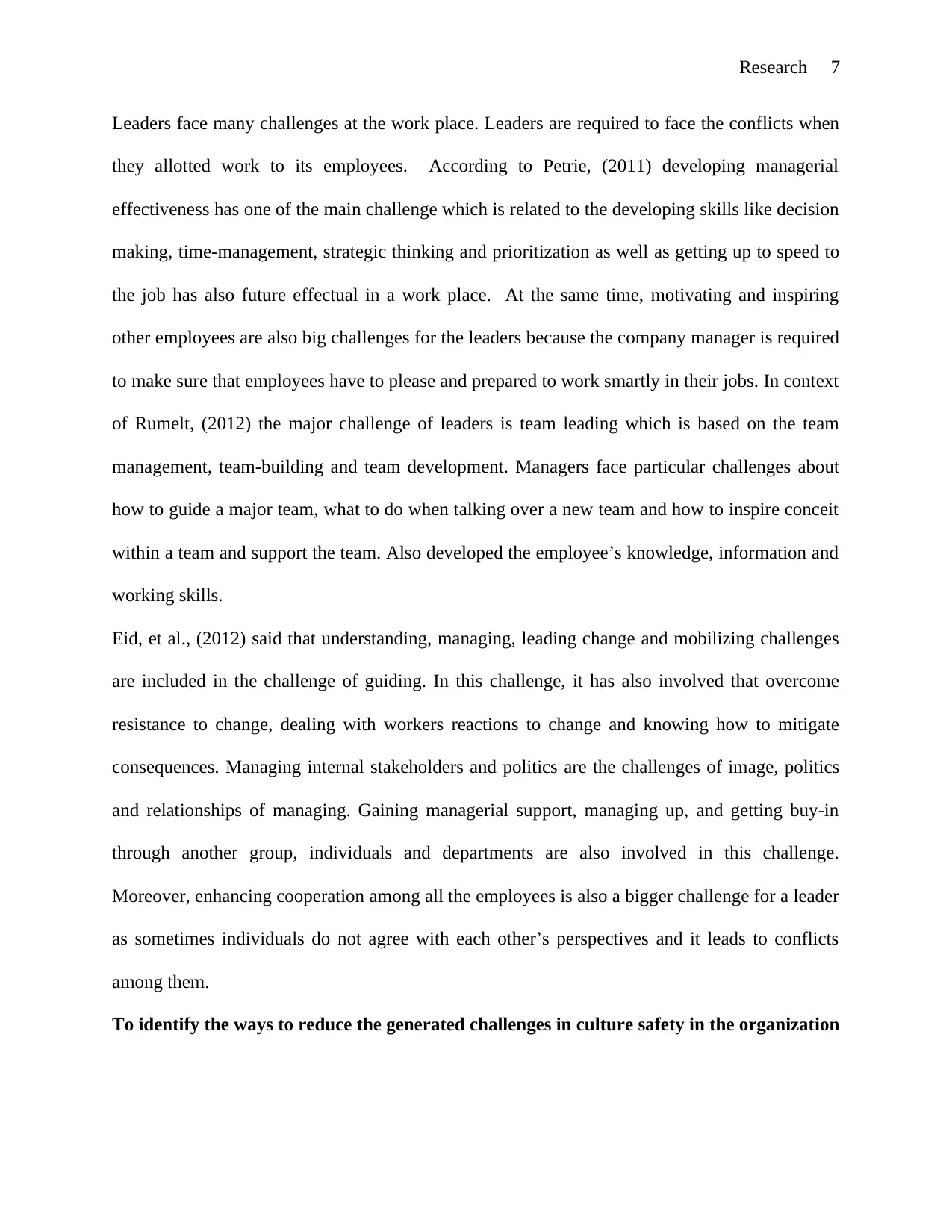
Research 7
Leaders face many challenges at the work place. Leaders are required to face the conflicts when
they allotted work to its employees. According to Petrie, (2011) developing managerial
effectiveness has one of the main challenge which is related to the developing skills like decision
making, time-management, strategic thinking and prioritization as well as getting up to speed to
the job has also future effectual in a work place. At the same time, motivating and inspiring
other employees are also big challenges for the leaders because the company manager is required
to make sure that employees have to please and prepared to work smartly in their jobs. In context
of Rumelt, (2012) the major challenge of leaders is team leading which is based on the team
management, team-building and team development. Managers face particular challenges about
how to guide a major team, what to do when talking over a new team and how to inspire conceit
within a team and support the team. Also developed the employee’s knowledge, information and
working skills.
Eid, et al., (2012) said that understanding, managing, leading change and mobilizing challenges
are included in the challenge of guiding. In this challenge, it has also involved that overcome
resistance to change, dealing with workers reactions to change and knowing how to mitigate
consequences. Managing internal stakeholders and politics are the challenges of image, politics
and relationships of managing. Gaining managerial support, managing up, and getting buy-in
through another group, individuals and departments are also involved in this challenge.
Moreover, enhancing cooperation among all the employees is also a bigger challenge for a leader
as sometimes individuals do not agree with each other’s perspectives and it leads to conflicts
among them.
To identify the ways to reduce the generated challenges in culture safety in the organization
Leaders face many challenges at the work place. Leaders are required to face the conflicts when
they allotted work to its employees. According to Petrie, (2011) developing managerial
effectiveness has one of the main challenge which is related to the developing skills like decision
making, time-management, strategic thinking and prioritization as well as getting up to speed to
the job has also future effectual in a work place. At the same time, motivating and inspiring
other employees are also big challenges for the leaders because the company manager is required
to make sure that employees have to please and prepared to work smartly in their jobs. In context
of Rumelt, (2012) the major challenge of leaders is team leading which is based on the team
management, team-building and team development. Managers face particular challenges about
how to guide a major team, what to do when talking over a new team and how to inspire conceit
within a team and support the team. Also developed the employee’s knowledge, information and
working skills.
Eid, et al., (2012) said that understanding, managing, leading change and mobilizing challenges
are included in the challenge of guiding. In this challenge, it has also involved that overcome
resistance to change, dealing with workers reactions to change and knowing how to mitigate
consequences. Managing internal stakeholders and politics are the challenges of image, politics
and relationships of managing. Gaining managerial support, managing up, and getting buy-in
through another group, individuals and departments are also involved in this challenge.
Moreover, enhancing cooperation among all the employees is also a bigger challenge for a leader
as sometimes individuals do not agree with each other’s perspectives and it leads to conflicts
among them.
To identify the ways to reduce the generated challenges in culture safety in the organization
Paraphrase This Document
Need a fresh take? Get an instant paraphrase of this document with our AI Paraphraser
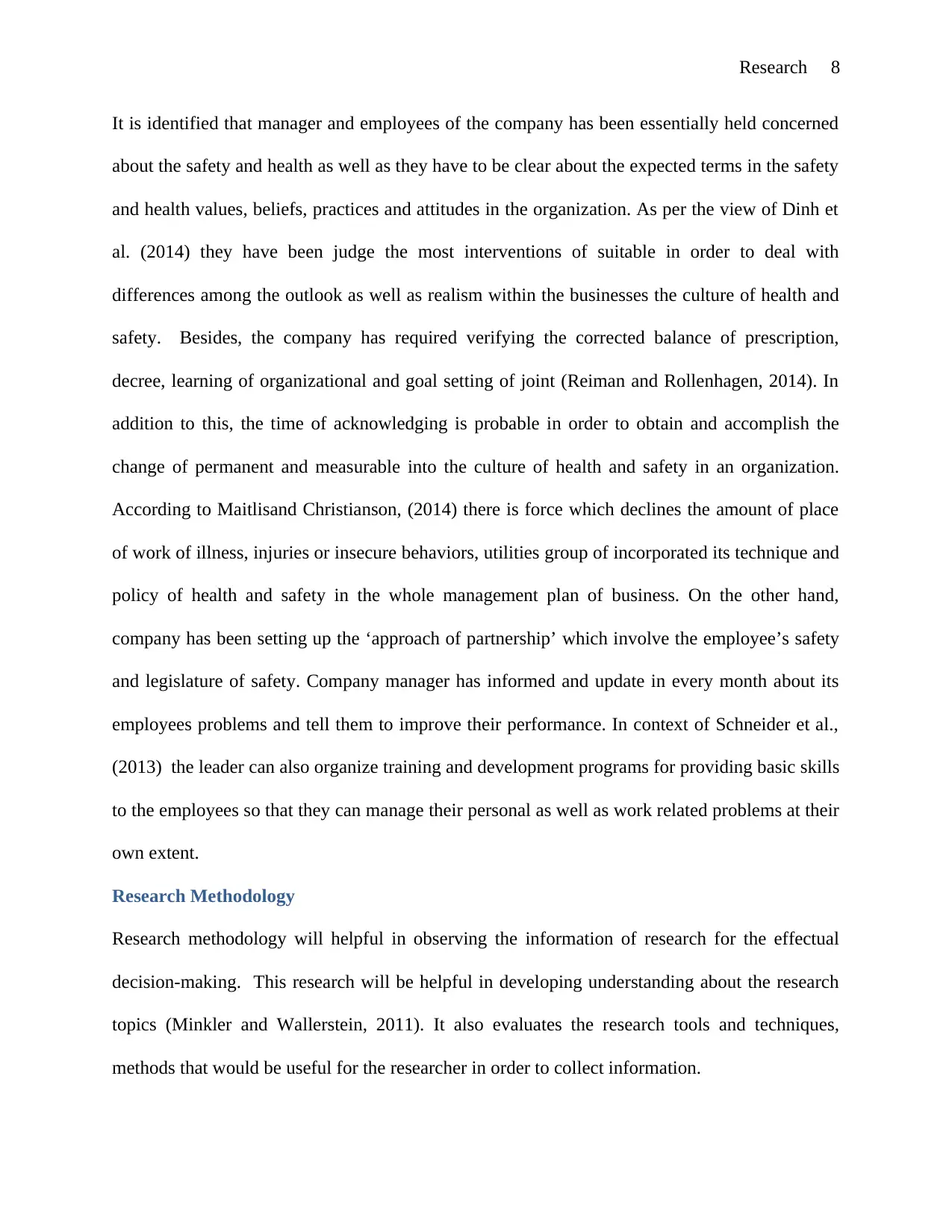
Research 8
It is identified that manager and employees of the company has been essentially held concerned
about the safety and health as well as they have to be clear about the expected terms in the safety
and health values, beliefs, practices and attitudes in the organization. As per the view of Dinh et
al. (2014) they have been judge the most interventions of suitable in order to deal with
differences among the outlook as well as realism within the businesses the culture of health and
safety. Besides, the company has required verifying the corrected balance of prescription,
decree, learning of organizational and goal setting of joint (Reiman and Rollenhagen, 2014). In
addition to this, the time of acknowledging is probable in order to obtain and accomplish the
change of permanent and measurable into the culture of health and safety in an organization.
According to Maitlisand Christianson, (2014) there is force which declines the amount of place
of work of illness, injuries or insecure behaviors, utilities group of incorporated its technique and
policy of health and safety in the whole management plan of business. On the other hand,
company has been setting up the ‘approach of partnership’ which involve the employee’s safety
and legislature of safety. Company manager has informed and update in every month about its
employees problems and tell them to improve their performance. In context of Schneider et al.,
(2013) the leader can also organize training and development programs for providing basic skills
to the employees so that they can manage their personal as well as work related problems at their
own extent.
Research Methodology
Research methodology will helpful in observing the information of research for the effectual
decision-making. This research will be helpful in developing understanding about the research
topics (Minkler and Wallerstein, 2011). It also evaluates the research tools and techniques,
methods that would be useful for the researcher in order to collect information.
It is identified that manager and employees of the company has been essentially held concerned
about the safety and health as well as they have to be clear about the expected terms in the safety
and health values, beliefs, practices and attitudes in the organization. As per the view of Dinh et
al. (2014) they have been judge the most interventions of suitable in order to deal with
differences among the outlook as well as realism within the businesses the culture of health and
safety. Besides, the company has required verifying the corrected balance of prescription,
decree, learning of organizational and goal setting of joint (Reiman and Rollenhagen, 2014). In
addition to this, the time of acknowledging is probable in order to obtain and accomplish the
change of permanent and measurable into the culture of health and safety in an organization.
According to Maitlisand Christianson, (2014) there is force which declines the amount of place
of work of illness, injuries or insecure behaviors, utilities group of incorporated its technique and
policy of health and safety in the whole management plan of business. On the other hand,
company has been setting up the ‘approach of partnership’ which involve the employee’s safety
and legislature of safety. Company manager has informed and update in every month about its
employees problems and tell them to improve their performance. In context of Schneider et al.,
(2013) the leader can also organize training and development programs for providing basic skills
to the employees so that they can manage their personal as well as work related problems at their
own extent.
Research Methodology
Research methodology will helpful in observing the information of research for the effectual
decision-making. This research will be helpful in developing understanding about the research
topics (Minkler and Wallerstein, 2011). It also evaluates the research tools and techniques,
methods that would be useful for the researcher in order to collect information.
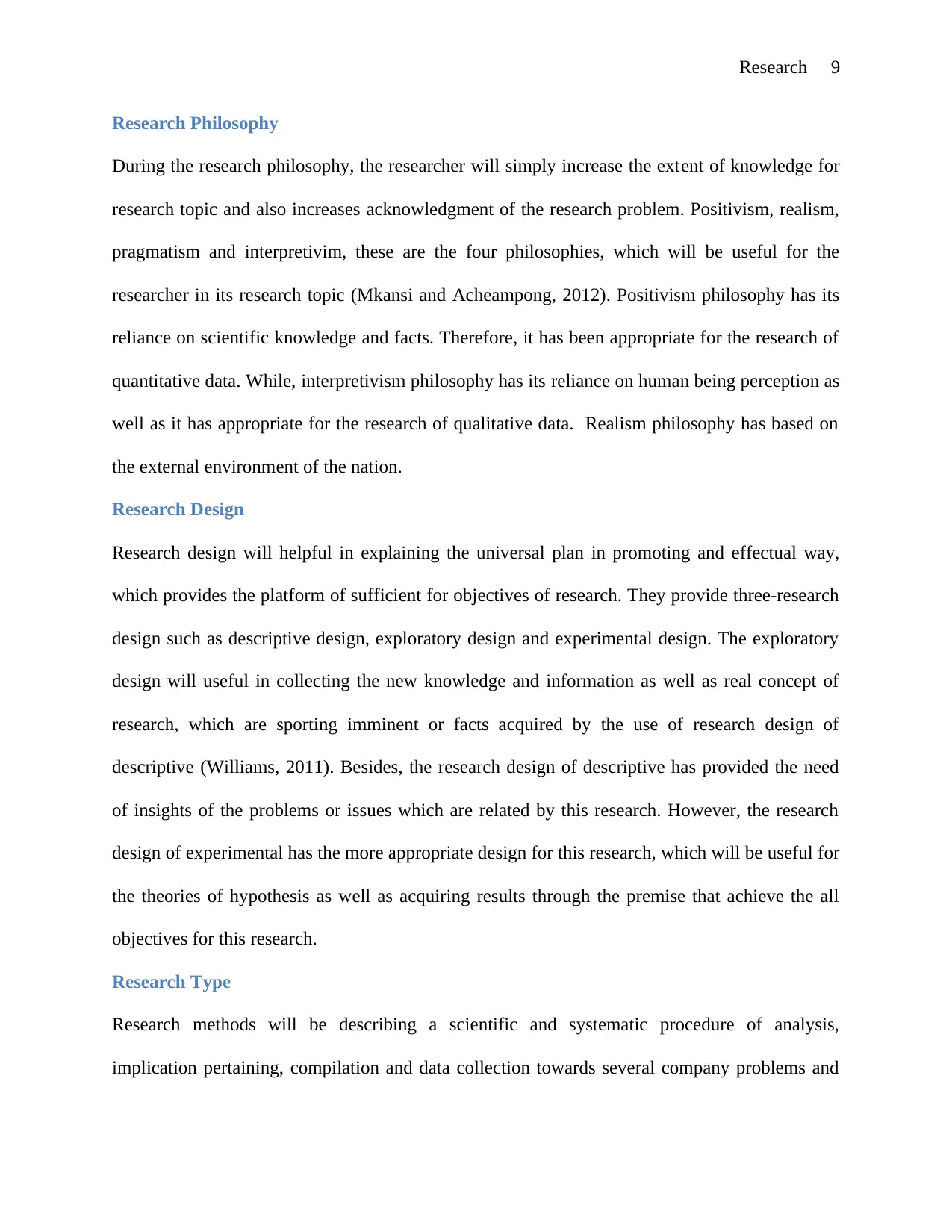
Research 9
Research Philosophy
During the research philosophy, the researcher will simply increase the extent of knowledge for
research topic and also increases acknowledgment of the research problem. Positivism, realism,
pragmatism and interpretivim, these are the four philosophies, which will be useful for the
researcher in its research topic (Mkansi and Acheampong, 2012). Positivism philosophy has its
reliance on scientific knowledge and facts. Therefore, it has been appropriate for the research of
quantitative data. While, interpretivism philosophy has its reliance on human being perception as
well as it has appropriate for the research of qualitative data. Realism philosophy has based on
the external environment of the nation.
Research Design
Research design will helpful in explaining the universal plan in promoting and effectual way,
which provides the platform of sufficient for objectives of research. They provide three-research
design such as descriptive design, exploratory design and experimental design. The exploratory
design will useful in collecting the new knowledge and information as well as real concept of
research, which are sporting imminent or facts acquired by the use of research design of
descriptive (Williams, 2011). Besides, the research design of descriptive has provided the need
of insights of the problems or issues which are related by this research. However, the research
design of experimental has the more appropriate design for this research, which will be useful for
the theories of hypothesis as well as acquiring results through the premise that achieve the all
objectives for this research.
Research Type
Research methods will be describing a scientific and systematic procedure of analysis,
implication pertaining, compilation and data collection towards several company problems and
Research Philosophy
During the research philosophy, the researcher will simply increase the extent of knowledge for
research topic and also increases acknowledgment of the research problem. Positivism, realism,
pragmatism and interpretivim, these are the four philosophies, which will be useful for the
researcher in its research topic (Mkansi and Acheampong, 2012). Positivism philosophy has its
reliance on scientific knowledge and facts. Therefore, it has been appropriate for the research of
quantitative data. While, interpretivism philosophy has its reliance on human being perception as
well as it has appropriate for the research of qualitative data. Realism philosophy has based on
the external environment of the nation.
Research Design
Research design will helpful in explaining the universal plan in promoting and effectual way,
which provides the platform of sufficient for objectives of research. They provide three-research
design such as descriptive design, exploratory design and experimental design. The exploratory
design will useful in collecting the new knowledge and information as well as real concept of
research, which are sporting imminent or facts acquired by the use of research design of
descriptive (Williams, 2011). Besides, the research design of descriptive has provided the need
of insights of the problems or issues which are related by this research. However, the research
design of experimental has the more appropriate design for this research, which will be useful for
the theories of hypothesis as well as acquiring results through the premise that achieve the all
objectives for this research.
Research Type
Research methods will be describing a scientific and systematic procedure of analysis,
implication pertaining, compilation and data collection towards several company problems and
⊘ This is a preview!⊘
Do you want full access?
Subscribe today to unlock all pages.

Trusted by 1+ million students worldwide
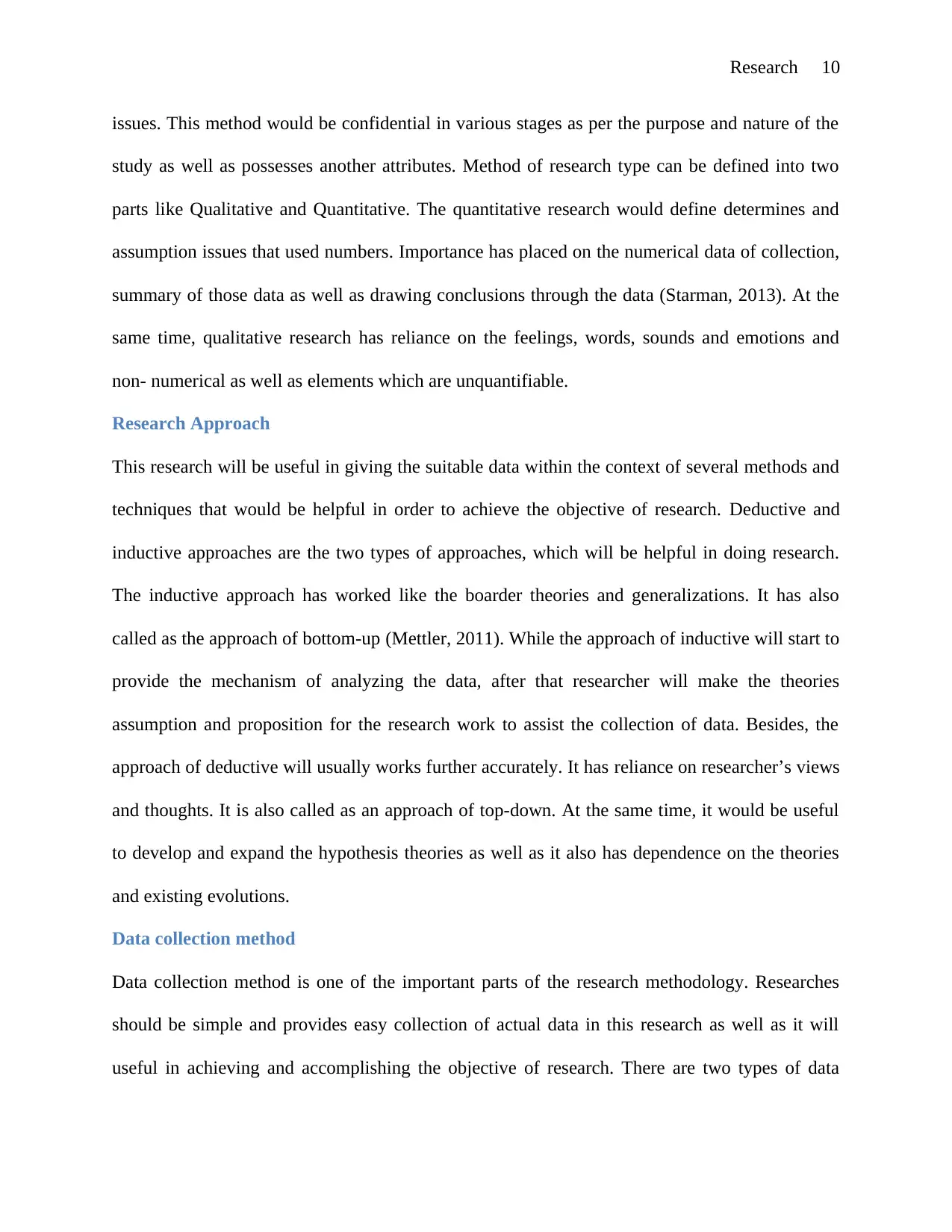
Research 10
issues. This method would be confidential in various stages as per the purpose and nature of the
study as well as possesses another attributes. Method of research type can be defined into two
parts like Qualitative and Quantitative. The quantitative research would define determines and
assumption issues that used numbers. Importance has placed on the numerical data of collection,
summary of those data as well as drawing conclusions through the data (Starman, 2013). At the
same time, qualitative research has reliance on the feelings, words, sounds and emotions and
non- numerical as well as elements which are unquantifiable.
Research Approach
This research will be useful in giving the suitable data within the context of several methods and
techniques that would be helpful in order to achieve the objective of research. Deductive and
inductive approaches are the two types of approaches, which will be helpful in doing research.
The inductive approach has worked like the boarder theories and generalizations. It has also
called as the approach of bottom-up (Mettler, 2011). While the approach of inductive will start to
provide the mechanism of analyzing the data, after that researcher will make the theories
assumption and proposition for the research work to assist the collection of data. Besides, the
approach of deductive will usually works further accurately. It has reliance on researcher’s views
and thoughts. It is also called as an approach of top-down. At the same time, it would be useful
to develop and expand the hypothesis theories as well as it also has dependence on the theories
and existing evolutions.
Data collection method
Data collection method is one of the important parts of the research methodology. Researches
should be simple and provides easy collection of actual data in this research as well as it will
useful in achieving and accomplishing the objective of research. There are two types of data
issues. This method would be confidential in various stages as per the purpose and nature of the
study as well as possesses another attributes. Method of research type can be defined into two
parts like Qualitative and Quantitative. The quantitative research would define determines and
assumption issues that used numbers. Importance has placed on the numerical data of collection,
summary of those data as well as drawing conclusions through the data (Starman, 2013). At the
same time, qualitative research has reliance on the feelings, words, sounds and emotions and
non- numerical as well as elements which are unquantifiable.
Research Approach
This research will be useful in giving the suitable data within the context of several methods and
techniques that would be helpful in order to achieve the objective of research. Deductive and
inductive approaches are the two types of approaches, which will be helpful in doing research.
The inductive approach has worked like the boarder theories and generalizations. It has also
called as the approach of bottom-up (Mettler, 2011). While the approach of inductive will start to
provide the mechanism of analyzing the data, after that researcher will make the theories
assumption and proposition for the research work to assist the collection of data. Besides, the
approach of deductive will usually works further accurately. It has reliance on researcher’s views
and thoughts. It is also called as an approach of top-down. At the same time, it would be useful
to develop and expand the hypothesis theories as well as it also has dependence on the theories
and existing evolutions.
Data collection method
Data collection method is one of the important parts of the research methodology. Researches
should be simple and provides easy collection of actual data in this research as well as it will
useful in achieving and accomplishing the objective of research. There are two types of data
Paraphrase This Document
Need a fresh take? Get an instant paraphrase of this document with our AI Paraphraser
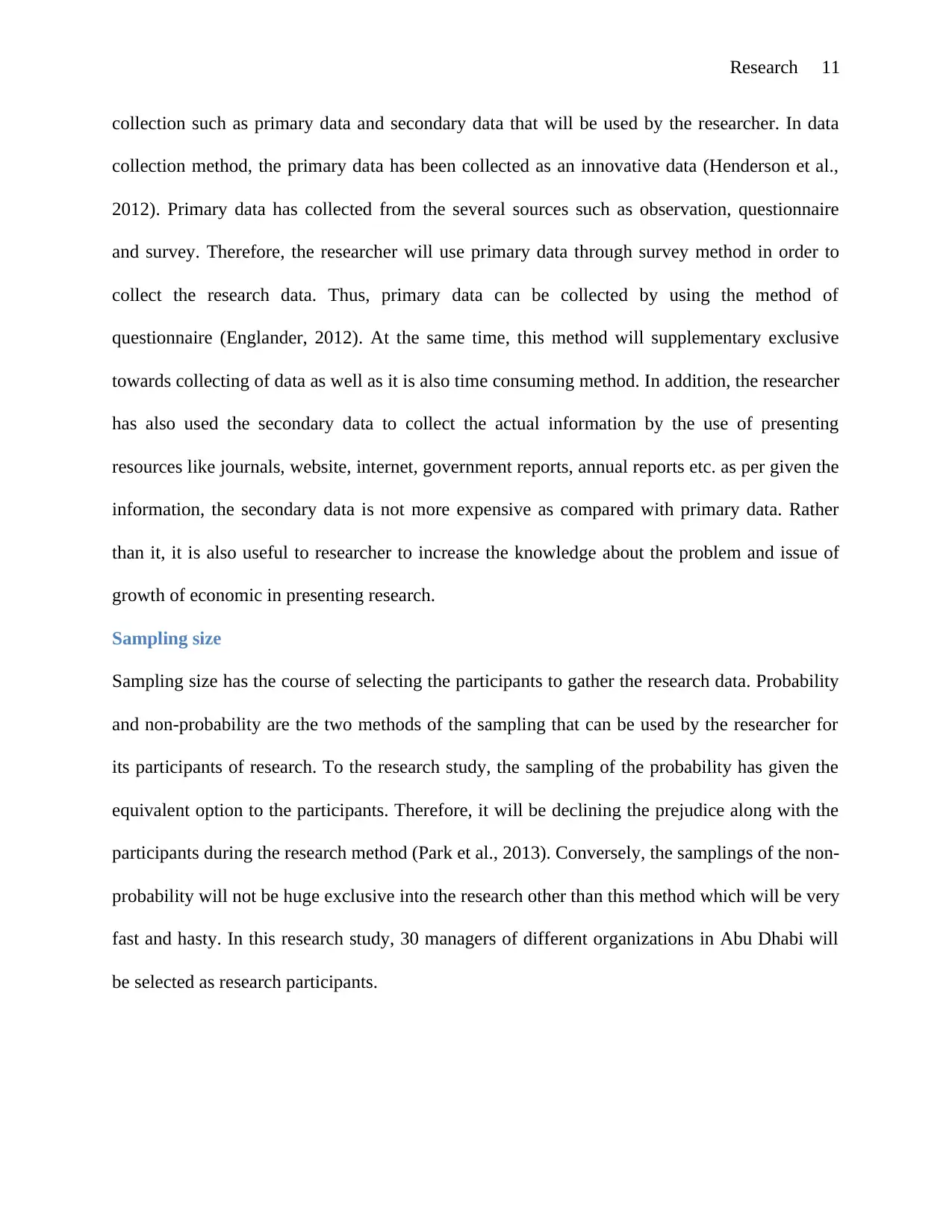
Research 11
collection such as primary data and secondary data that will be used by the researcher. In data
collection method, the primary data has been collected as an innovative data (Henderson et al.,
2012). Primary data has collected from the several sources such as observation, questionnaire
and survey. Therefore, the researcher will use primary data through survey method in order to
collect the research data. Thus, primary data can be collected by using the method of
questionnaire (Englander, 2012). At the same time, this method will supplementary exclusive
towards collecting of data as well as it is also time consuming method. In addition, the researcher
has also used the secondary data to collect the actual information by the use of presenting
resources like journals, website, internet, government reports, annual reports etc. as per given the
information, the secondary data is not more expensive as compared with primary data. Rather
than it, it is also useful to researcher to increase the knowledge about the problem and issue of
growth of economic in presenting research.
Sampling size
Sampling size has the course of selecting the participants to gather the research data. Probability
and non-probability are the two methods of the sampling that can be used by the researcher for
its participants of research. To the research study, the sampling of the probability has given the
equivalent option to the participants. Therefore, it will be declining the prejudice along with the
participants during the research method (Park et al., 2013). Conversely, the samplings of the non-
probability will not be huge exclusive into the research other than this method which will be very
fast and hasty. In this research study, 30 managers of different organizations in Abu Dhabi will
be selected as research participants.
collection such as primary data and secondary data that will be used by the researcher. In data
collection method, the primary data has been collected as an innovative data (Henderson et al.,
2012). Primary data has collected from the several sources such as observation, questionnaire
and survey. Therefore, the researcher will use primary data through survey method in order to
collect the research data. Thus, primary data can be collected by using the method of
questionnaire (Englander, 2012). At the same time, this method will supplementary exclusive
towards collecting of data as well as it is also time consuming method. In addition, the researcher
has also used the secondary data to collect the actual information by the use of presenting
resources like journals, website, internet, government reports, annual reports etc. as per given the
information, the secondary data is not more expensive as compared with primary data. Rather
than it, it is also useful to researcher to increase the knowledge about the problem and issue of
growth of economic in presenting research.
Sampling size
Sampling size has the course of selecting the participants to gather the research data. Probability
and non-probability are the two methods of the sampling that can be used by the researcher for
its participants of research. To the research study, the sampling of the probability has given the
equivalent option to the participants. Therefore, it will be declining the prejudice along with the
participants during the research method (Park et al., 2013). Conversely, the samplings of the non-
probability will not be huge exclusive into the research other than this method which will be very
fast and hasty. In this research study, 30 managers of different organizations in Abu Dhabi will
be selected as research participants.
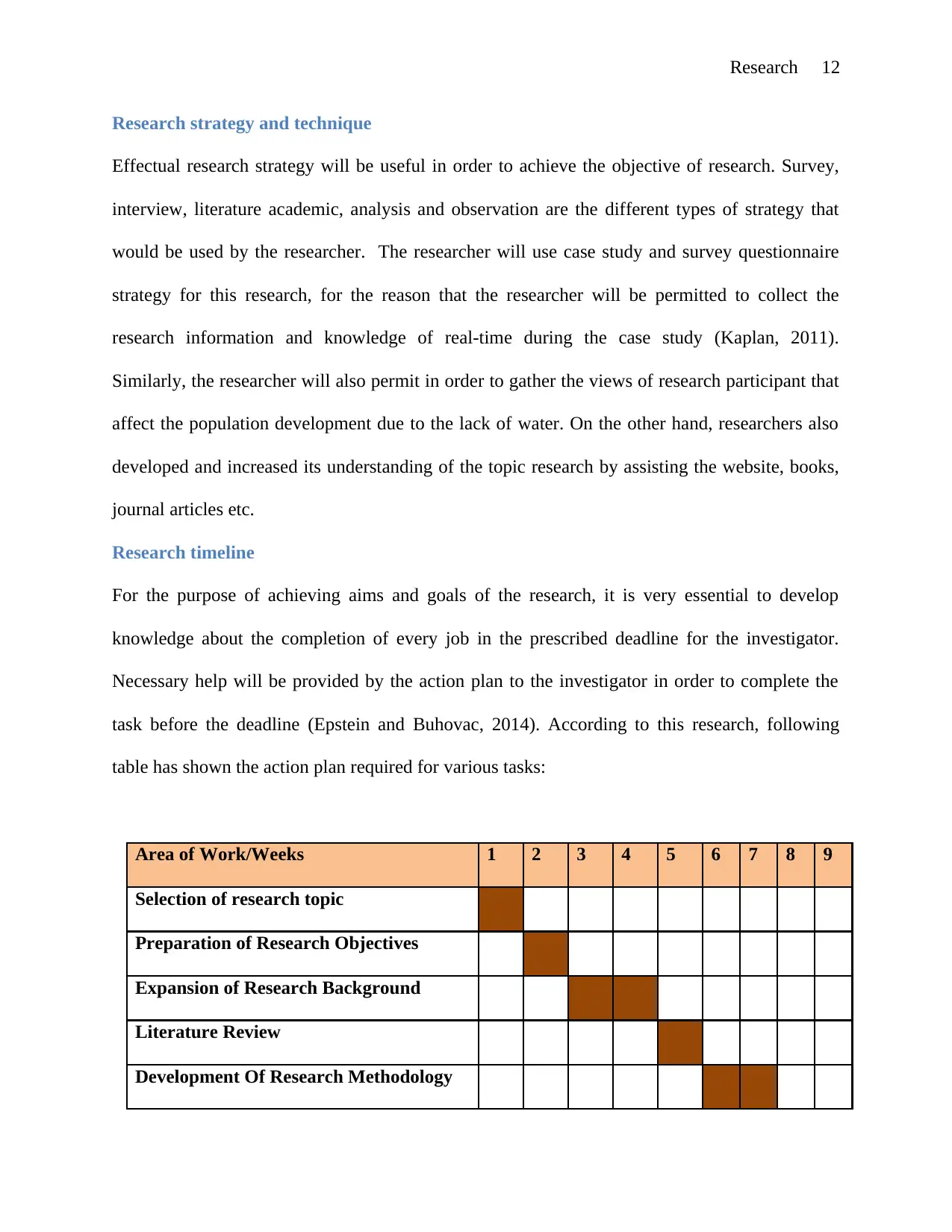
Research 12
Research strategy and technique
Effectual research strategy will be useful in order to achieve the objective of research. Survey,
interview, literature academic, analysis and observation are the different types of strategy that
would be used by the researcher. The researcher will use case study and survey questionnaire
strategy for this research, for the reason that the researcher will be permitted to collect the
research information and knowledge of real-time during the case study (Kaplan, 2011).
Similarly, the researcher will also permit in order to gather the views of research participant that
affect the population development due to the lack of water. On the other hand, researchers also
developed and increased its understanding of the topic research by assisting the website, books,
journal articles etc.
Research timeline
For the purpose of achieving aims and goals of the research, it is very essential to develop
knowledge about the completion of every job in the prescribed deadline for the investigator.
Necessary help will be provided by the action plan to the investigator in order to complete the
task before the deadline (Epstein and Buhovac, 2014). According to this research, following
table has shown the action plan required for various tasks:
Area of Work/Weeks 1 2 3 4 5 6 7 8 9
Selection of research topic
Preparation of Research Objectives
Expansion of Research Background
Literature Review
Development Of Research Methodology
Research strategy and technique
Effectual research strategy will be useful in order to achieve the objective of research. Survey,
interview, literature academic, analysis and observation are the different types of strategy that
would be used by the researcher. The researcher will use case study and survey questionnaire
strategy for this research, for the reason that the researcher will be permitted to collect the
research information and knowledge of real-time during the case study (Kaplan, 2011).
Similarly, the researcher will also permit in order to gather the views of research participant that
affect the population development due to the lack of water. On the other hand, researchers also
developed and increased its understanding of the topic research by assisting the website, books,
journal articles etc.
Research timeline
For the purpose of achieving aims and goals of the research, it is very essential to develop
knowledge about the completion of every job in the prescribed deadline for the investigator.
Necessary help will be provided by the action plan to the investigator in order to complete the
task before the deadline (Epstein and Buhovac, 2014). According to this research, following
table has shown the action plan required for various tasks:
Area of Work/Weeks 1 2 3 4 5 6 7 8 9
Selection of research topic
Preparation of Research Objectives
Expansion of Research Background
Literature Review
Development Of Research Methodology
⊘ This is a preview!⊘
Do you want full access?
Subscribe today to unlock all pages.

Trusted by 1+ million students worldwide
1 out of 18
Related Documents
Your All-in-One AI-Powered Toolkit for Academic Success.
+13062052269
info@desklib.com
Available 24*7 on WhatsApp / Email
![[object Object]](/_next/static/media/star-bottom.7253800d.svg)
Unlock your academic potential
Copyright © 2020–2025 A2Z Services. All Rights Reserved. Developed and managed by ZUCOL.




